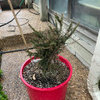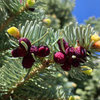Picea omorika 'Nana' - tall or short ?
texjagman
11 years ago
Had a question......
I have seen several examples of this serbian spruce up to a beautiful specimen that had to be at least 10 years old. And in every case they were nice thickly branched globes. The largest was about 5' round with no vertical growth.
But last week several of our big box stores got in some labeled as Nana and in all the shipments they were all fairly narrow pyramids about 4-5' tall, with strong leader growth. At first I immediately thought they were mislabeled. So I went back out online to google more info and found this reference from Will a while back:
" This medium growing omorika dwarf is often grown in tiny spots with hopes it develops into a narrow, compact plant. Well, in the Pacific Northwest, at least, this hope is dashed fairly quickly. Here it grows a healthy 6 inches a year and forms a squat pyramid. Bob Fincham, who has forgotten more about conifers then I will ever know, has mentioned it may grow upwards of twelve inches in the right(or wrong?) conditions. "
So give me opinions.....is it mostly a glode that can or may eventually send up a leader, or is it more apt to be a pyramid like I'm seeing in the stores right now? Do you think these are mislabeled?
mark




David Olszyk, President, American Conifer Society
arceesmith
Related Professionals
Edmond Landscape Architects & Landscape Designers · Garden City Landscape Architects & Landscape Designers · Rancho Cordova Landscape Architects & Landscape Designers · Mooresville Landscape Contractors · Annandale Landscape Contractors · Bainbridge Island Landscape Contractors · Barrington Landscape Contractors · Eustis Landscape Contractors · Fishers Landscape Contractors · Fort Wayne Landscape Contractors · Milford Landscape Contractors · Oxnard Landscape Contractors · Quincy Landscape Contractors · Four Corners Landscape Contractors · North Hills Landscape Contractorstsugajunkie z5 SE WI ♱
greatplainsturf
Embothrium
greatplainsturf
David Olszyk, President, American Conifer Society
greatplainsturf
greatplainsturf
David Olszyk, President, American Conifer Society
Embothrium
texjagmanOriginal Author
texjagmanOriginal Author
Embothrium
texjagmanOriginal Author
tunilla
Embothrium